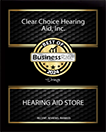
Is it possible to comfortably wear hearing aids while you are also wearing your glasses, even though the two don’t seem very compatible? If you are thinking about a behind-the-ear (BTE) device, this typical question is even more pertinent. People often wonder whether or not they can work together comfortably. Yes is the answer.
People who wear glasses should consider some things before investing in new hearing aids. Use these suggestions to be sure your hearing aids and glasses work well together.
What Kind of Hearing Aids Will Work Best for You?
There are quite a few things, in general, to think about when investing in new hearing aids. You can get hearing aids in many sizes, styles, and shapes. You can even get them in a cool color if you like. Modern high tech hearing aids are not like the ones that grandpa used.
Understanding exactly what type of hearing aids are available is the way to start the search. They divide into three basic categories:
- In-the-canal (ITC) – This style is very much like the ITE model but it sits deeper into the ear, making them nearly invisible.
- In-the-ear (ITE) – As the name implies, this format of hearing aid fits directly into the opening of the ear canal with nothing mounted behind the ear.
- Behind-the-ear (BTE) – This is an older style of hearing aid, but today’s version of this technology is way more advanced. With this model, the main section of the device mounts right behind the ear with clear tubing that connects to an earmold sitting in the opening of the ear canal. Open-fit versions are basically the same setup but without the earmold.
If you wear glasses, you can stay clear of a lot of problems with ITE and ITC models. Once you decide on the physical style, it’s time to review the features of different hearing aids.
Understanding The Different Features
It’s really the features not the shape of the hearing aid that should be your primary concern when researching. Hearing aid technology is evolving all the time, so features constantly change. Watch for some of these common ones:
- T-coil – This feature permits you to hear better while talking on a land-line phone. T-coil technology is useful if you are listening to people talk through a speaker like at a bingo game or on the radio.
- Noise reduction – Filters out background noise by amplifying one channel to augment speech.
- Directional microphone – This will help pinpoint the sound you need to hear while you are in a noisy spot. For example, if someone is talking to you at a party, you can hear their speech easily in spite of the noise all around you.
Your aim is to determine the right set of features and functions to fit your lifestyle. Then the style of the hearing aid can be selected.
What if You Want BTE Hearing Aids?
BTE hearing aids can be worn with glasses. The secret is to wear both of these important accessories correctly, so they fit comfortably. Here are some tips:
- Practice taking your glasses off by pulling them forward with both hands instead of pulling them up with one. It will take some time before you form a habit of removing them this way. The practice will be reinforced every time you knock off your hearing aid.
- Get in the habit of putting your glasses on first and then your hearing aids. You can maneuver your hearing aid around the arm of your glasses which sits a little more rigidly. To be sure that the hearing aid isn’t hanging from your outer ear, after you place it, look in the mirror.
- Select the appropriate size BTE before you commit to a purchase. Although the traditional size will still work with glasses, it’s a little bit bulky. The mini BTE is a relatively new option. The part that fits behind the ear is much smaller for enhanced comfort and also to reduce the feedback that you sometimes get with the BTE units. You have to try out both styles to determine which one works best.
The only possibility for those that have a real problem wearing a BTE device with glasses would be the ITE or ITC devices. As an example, if you take your glasses off a lot, BTE devices will be a much greater burden. Children and people with smaller ears will struggle with this combination, too. Which style is best for you can be determined if you schedule an appointment with a hearing aid specialist and take advantage of the free trial. Use this trial to see if you can wear both or not.










